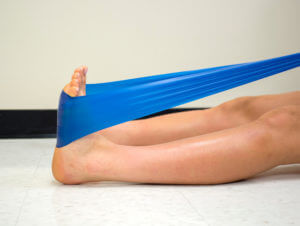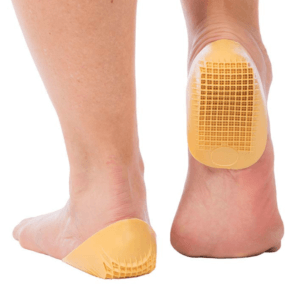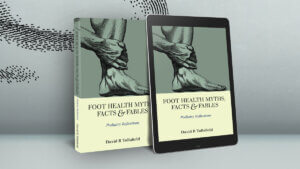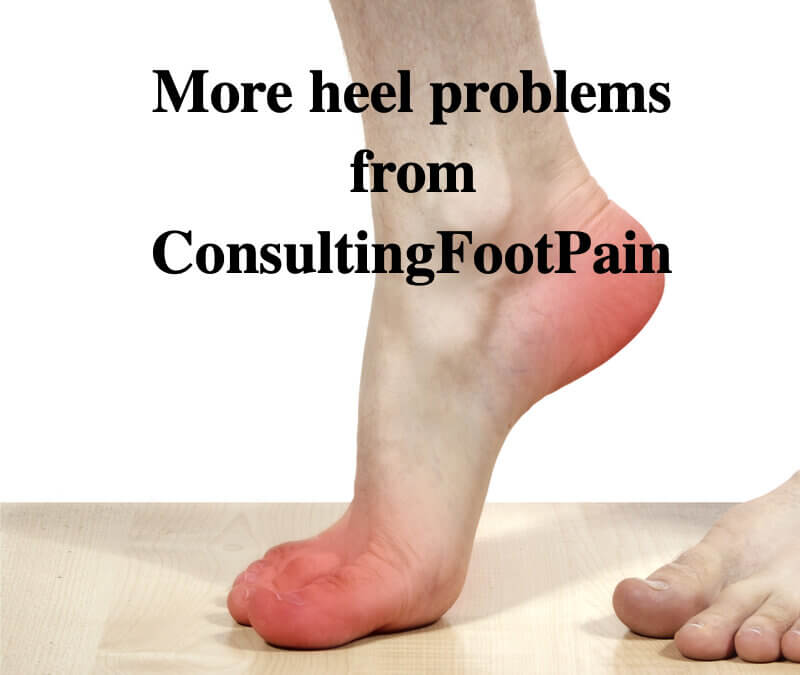Confusion about heel pain
The most common types of heel pain problems arise from general overuse or repetitive heel pad strain but heel pain is complex and if left can resist treatment. In this article, there are four key subjects that you need to know about. The first relates to children while the other conditions are adult related. There are conditions such as rheumatoid arthritis, gout and ankylosing spondylitis that may affect the heel as well as rarer conditions and of course fractures. If the pain does not subside with self-help remedies recommended after several weeks, then seek professional medical help from a podiatrist or medical practitioner.
- Sever’s disease (apophysitis)
- Haglund’s heel bump
- Repetitive heel pad strain
- Plantar fasciitis
You go to YouTube and find out about most foot conditions. The USA is by far the most prolific film-maker on ‘how to’ but remember there is often a sales pitch behind such films. The first myth you need to be mindful of is the heel spur. Of course, I have my own pitch on heel pain which may also provide useful first aid remedies. Surgery is not considered in this article, but my current recommendation is the website FootEducation.com for further information representing impartial no-nonsense advice produced by health professionals specialising in feet.
Children and adults present with heel pain problems for different reasons. In this article, I hope we can make some sense of this? Severs apophysitis (children) and Haglund’s heel bump (children & adults). Fasciitis and heel pad strain for adults. Read bout the myth of the heel spur together with these common problems when you download my FREE self-help sheet Self-help Heel pain – pull out sheet.
Other related articles on heel pain problems on ConsultingFootPain
What’s the difference between fasciitis and plantar fibromatosis?
Sever’s diseases or calcaneal apophysitis
In a child (10-16) the growth plate can become irritated. It is not a disease and is often thought of as growing pains. The problem arises where sections of bone determined by the growth plate meet to contribute to the lengthening of the bone and are put under strain from an overactive Achilles tendon.
Remedy: Apophysitis
The most important thing that any parent can do is to ensure there is no visible reason for heel pain. A blister, verruca, small hair from an animal. Get the magnifying glass and have a good look. Is the heel hot and swollen, painful to touch and does simple pain medicine make no difference? If pain cannot be relieved by medication seek professional help especially if the foot has been rested.
Apophysitis in adolescents actually is self-limiting and all we are doing is waiting for the two sites making up the heel bone to mature i.e join together. The aim is to remove the tension-pull effect on the smaller part of the heel. To do this raise the heel with a 1/4 in foam or felt pad, or use a heel pad from a sports shop used for heel pain. Nothing more is required. Adjust the thickness, and put two pieces together if necessary. Felt compresses and thins out so it needs replacing and this is why it is only good as a temporary measure. A denser, firmer pad lasts longer so shop around.
You can rub ant-inflammatory gels over the heel to help as well, but rest and stopping high activity sports are important for a week to ten days, then reduce the frequency for up to six weeks allowing the heel to settle. Of our four children, it was only the male who developed this problem and indeed it self cured, perhaps with a little help from Dad!
Heel bump or Haglund’s deformity
A condition that affects children and adults
The bump is not prominent, as shown in Haglund’s disease (deformity) below. As with the heel spur which lies under the heel bone, traction pulls at the back of the heel from the big Achilles tendon. This can arises during adolescence and later in life when increased activity triggers pain and inflammation. The Achilles tendon is often the site where the tendon produces harmless spurs. Heel pain for the young person can be quite distressing but more so after activity. X-rays are usually unremarkable and are not always required.


The bump (below) is shown inside the profile and consists of bone and overlying soft tissue. Gel sleeve (above right). The pad is contoured and made as a sleeve or half sock
The bump arises most commonly in adults although can occur in adolescents. Known also as a retrocalcaneal exostosis and Haglund’s deformity names are often confusing. Symptoms are easier to spot because discomfort arises over the bump. Many shoes can irritate the location so select shoes around the heel. The telltale sign is the bump illustrated. Apart from the obvious increase in the size of the heel, the inner heel lining is worn at one point. Redness and tenderness can be due to simple friction or chilblains during the autumn and winter seasons.
Remedy: Haglund’s deformity
- If the skin is damaged this should be protected by a blister dressing or felt pad. Blister dressings are available from high street pharmacies often with their foot care products. Made from a gel this cushions and is water-resistant.
- Felt pads are often best fitted inside the shoe and should have a cavity created to take away pressure from the bump.
- A soft sac or bursa can form over the skin and needs protecting from friction
- A heel lift may be useful to change the position. ¼ inch (6mm) felt or foam insert works well
- I have personally found a gel pad similar to the one illustrated above useful but replacement is required with heavy use. These are great in walking boots
Repetitive heel pad strain

Reading the literature it is easy to believe that heel = fasciitis. In truth sometimes this is possible and the two exist, at other times this is not the case, despite management often overlapping. I have had both conditions myself, fasciitis and heel pain, the latter being an overuse syndrome. Fasciitis came on midway through a family camping holiday when I was in my mid-thirties. Heel pain arose after I decided to keep fit and used a treadmill aggressively at 45 years of age. Location can offer a guide. Read my article on bruised heel pain
Remedy: general advice for heel pain
Long-standing periods and work shifts (above 8 to 10 hours) will make heel pain worse.
- Pain killers work to reduce pain but will not resolve the problem. Stop excessive exercise for 2-3 weeks.
- Use a foam heel pad such as silicone jelly.
- Sports shops also sell thin heel pads without taking up too much room but pads of this type are short-lived. Heel lift pads can be used for Sever’s disease.
- If pain persists, or increases in intensity, then seek help no later than 4-6
- gently daily about three times a day using a Thera band as shown or stretch the band against the ground as in tendo Achilles stretches. The tendo Achilles and fascia share a close relationship.
- Tuli heel cup is well worth considering and works well for many heel pain sufferers. Sourced through the internet so freely available with a prescription.
- Check your footwear for any cause of the problem and try to re-negotiate shorter shifts at work, or change roles so some of the time you are sitting.
- If within a month the pain is still present, then seek assistance or earlier if the pain escalates.


Illustrations show Thera band stretch (Above) and Tuli Heel cup (Below
Plantar Fasciitis
 (See my other article on this website and what the internet says about fasciitis)
(See my other article on this website and what the internet says about fasciitis)
Fasciitis arises less frequently than heel pad pain. However, fasciitis can involve the heel pad and arch and can become disabling if not treated. Follow the same advice for heel pad pain for the same time periods but remain as active as possible, but do not exert the foot, i.e run or undertake sports requiring squats or springing until the symptoms have calmed. High heeled shoes may actually be more beneficial.
Remedy: plantar fasciitis
- Once the pain starts if the area is tender to press, avoid arch supports initially.
- Use localised non-steroidal gel or creams or locally applied warming creams**
- Apply local strapping (see fan design) to remove tension
- Increase heel height inside the shoe up to ¼ in 6mm
- Once pain is easier, longer-term help can be gained from an orthosis.
- Stretching once the condition improves helps prevent reoccurrence as shown with Theraband.
- Also, use stretches for the tendo Achilles
- Use a small rolling pin, cylinder to provide some deep massage
** Warming creams contain salicylates such as methyl salicylate and they are heat making when rubbed onto the skin. The idea is to bring fresh blood to the area and speed up healing on non-infected unbroken skin.
Burning pain and tarsal tunnel need to be ruled out – here are some ideas about what to look for.
Surgery – Read John’s experience and when to consider this form of management.
Thanks for reading ‘More Heel Problems’ by David R Tollafield
Why not read Foot Health Myths Facts & Fables available from Amazon books

Published by Busypencilcase Communications Est. 2015 for ConsultingFootPain


Recent Comments